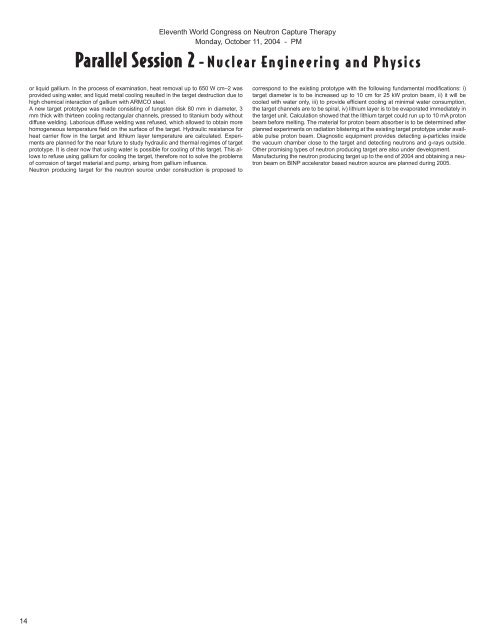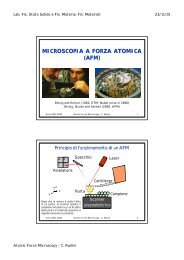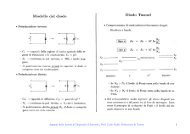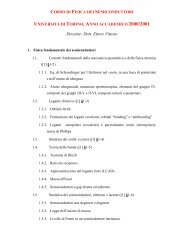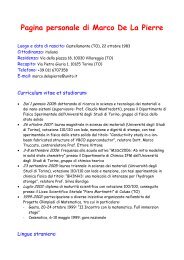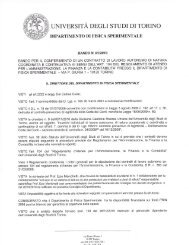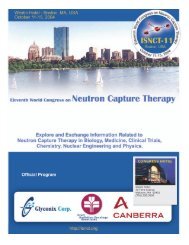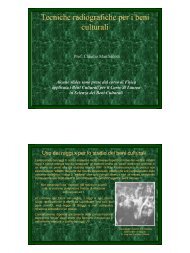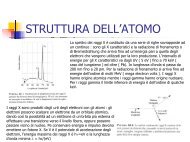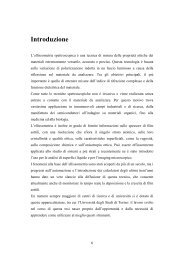Eleventh World Congress on Neutron Capture TherapyMonday, October 11, 2004 - PMParallel Session 2 - N u c l ea r E n g i n e e r i n g a n d P hy s i c sor liquid gallium. In the process of examination, heat removal up to 650 W cm–2 wasprovided using water, and liquid metal cooling resulted in the target destruction due tohigh chemical interaction of gallium with ARMCO steel.A new target prototype was made consisting of tungsten disk 80 mm in diameter, 3mm thick with thirteen cooling rectangular channels, pressed to titanium body withoutdiffuse welding. Laborious diffuse welding was refused, which allowed to obtain morehomogeneous temperature field on the surface of the target. Hydraulic resistance forheat carrier flow in the target and lithium layer temperature are calculated. Experimentsare planned for the near future to study hydraulic and thermal regimes of targetprototype. It is clear now that using water is possible for cooling of this target. This allowsto refuse using gallium for cooling the target, therefore not to solve the problemsof corrosion of target material and pump, arising from gallium influence.Neutron producing target for the neutron source under construction is proposed tocorrespond to the existing prototype with the following fundamental modifications: i)target diameter is to be increased up to 10 cm for 25 kW proton beam, ii) it will becooled with water only, iii) to provide efficient cooling at minimal water consumption,the target channels are to be spiral, iv) lithium layer is to be evaporated immediately inthe target unit. Calculation showed that the lithium target could run up to 10 mA protonbeam before melting. The material for proton beam absorber is to be determined afterplanned experiments on radiation blistering at the existing target prototype under availablepulse proton beam. Diagnostic equipment provides detecting a-particles insidethe vacuum chamber close to the target and detecting neutrons and g-rays outside.Other promising types of neutron producing target are also under development.Manufacturing the neutron producing target up to the end of 2004 and obtaining a neutronbeam on BINP accelerator based neutron source are planned during 2005.14
Eleventh World Congress on Neutron Capture TherapyTuesday, October 12, 2004 - AMDosimetry - N u c l ea r E n g i n e e r i n g , P hy s i c s , & C l i n i ca l A p p l i ca t i o n sSession Chairs: Milan Marek, Stuart Green8:30 AM -In-phantom characterisation studies at the BirminghamAccelerator-Generated epIthermal Neutron Source(BAGINS) BNCT facility. Christopher N. Culbertson a , Stuart Green b, *,Anna J. Mason a , David Picton a , Gareth Baugh a , Richard P. Hugtenburg a,b ,Zaizhe Yin a , Malcolm C. Scott a , John M. Nelson aa School of Physics and Astronomy, University of Birmingham, Birmingham B15 2TT,UK, b Department of Medical Physics, University Hospital Birmingham, Queen ElizabethHospital, Edgbaston, Birmingham B15 2TH, UKThis revised paper is presented posthumously under the name of the originallead author Dr. Chris Culbertson. It is dedicated to his memory.A broad experimental campaign to validate the final, constructed epithermal neutronbeam for BNCT at the University of Birmingham concluded in November 2003. Thefinal moderator and facility designs are overviewed briefly, followed by a summary ofthe dosimetric results from this campaign. The dual ionisation chamber technique wasused together with foil activation to quantify the fast neutron, photon, and thermal neutronbeam dose components along the beam-axis and perpendicular to the beam-lineaxis at two depths in a large rectangular phantom exposed to the beam with a 12 cmdiameter beam delimiter in place.The Dynamitron accelerator at the University of Birmingham has demonstrated acceleratedproton currents in excess of 1 mA at a potential of 2.8 MV. The proton beamstrikes a thick natural lithium target positioned at the centre of a moderating structure,generating a neutron source intensity of 1.37x10^12n/s at 1 mA via the 7Li(p,n)7Bereaction. Designs utilizing this source for epithermal beam production have been proposedand investigated through simulations and experimental measurements. Thecompleted and commissioned facility design applies a region of FluentalTM to moderatethe neutron spectrum to appropriate therapy energies and a lithiated polyethylenesheet to provide a delimited neutron beam port. An impingent flow, heavy water coolingsystem is used to cool the copper backing plate of the thick lithium target, preventingliquification of the horizontally aligned target. This heat removal system has demonstratedadequate heat removal at up to 1 mA operation.Dose measurements agree with in-phantom MCNP4C predictions within 10% for thephoton dose, within 10% for thermal neutron dose, and within 25% for the protonrecoil dose along the main beam axis. The results of this measurement are comparedwith calculation and summarized in Table 1. Further beam studies utilized fission andionisation chambers for in-air scans of thermal neutron fluence and photon and fastneutron doses across the front of the moderator and found similar levels of agreementwith calculation. The relative contribution from each component was found to be highlysimilar to facilities already utilized in BNCT clinical trials.This is the first publication of dose characteristics of the intended therapy beam, measuredat clinical beam power. As such it is a unique set of measurements of what weanticipate will be the world’s first clinical accelerator-based BNCT beam.scaling factors to relate the separate dose components between the different institutesare being determined. Preliminary normalization of measured and calculateddosimetry for patients is nearing completion to enable the physical radiation doses thatcomprise a treatment prescription at a host institute to be directly related to the correspondingmeasured doses of a visiting group. This should serve as an impetus forthe direct comparison of patient data although the clinical requirements for achievingthis need to be clearly defined. This may necessitate more extensive comparisons oftreatment planning calculations through the solution of test problems and clarificationregarding the question of dose specification from treatment calculations in general.9:30 AM -Measurement of free beam neutron spectra at eightBNCT facilities worldwide. I. Auterinen a, *, T. Serén a , K. Anttila a , A.Kosunen b , S. Savolainen c,da VTT Processes, POB 1608, FIN-02044 VTT, Finland, b Radiation Metrology Laboratory,Radiation and Nuclear Safety Authority-STUK, POB 14, FIN-00881 Helsinki,Finland, c Department of Physical Sciences, University of Helsinki, POB 64, FIN-00014 Finland, d Helsinki Medical Imaging Center, University of Helsinki, P.O. Box340, FIN-00029 HUS, FinlandIntroduction: As part of the “International Dosimetry Exchange” project the dosimetrygroup from VTT has determined the neutron spectrum in BNCT beams using the multifoilactivation detector method. Measurements have been made on the already closedepithermal BNCT facility at the BMRR of the Brookhaven National Laboratory, on theHFR at JRC in Petten, The Netherlands, on the mixed mode beam at KURRI, Japan,on the fission converter beam (FCB) at MIT, USA, on the epithermal beam of the RA-6facility in Bariloche, Argentina, on the epithermal beam at WSU, USA, on the mixedmode beam at JRR-4 at JAERI, Japan, as well as on the epithermal beam at FiR 1 atVTT, Espoo, Finland.Materials and methods: 10 different detector isotopes, majority of them diluted into Alin order to minimize self-shielding effects, were irradiated both in a bare stack and ina cadmium capsule. Additionally, for the fast neutron activation reactions about 1 gplates of Al and In are irradiated in a Cd-capsule which is placed inside a sphere with10 mm thick walls of 10B giving very efficient shielding against thermal as well as mostepithermal neutrons. After irradiation the induced activities in the foils were measuredwith local gammaspectrometry systems. Saturation activities and reaction rates weredetermined. Beam monitor records were used, when available, to judge the correctirradiation time and to normalize the saturation activities from different irradiations toa nominal value. At each facility the calculated neutron spectrum from a beam modelused locally in the dosimetry work and/or in the treatment planning was used. Thecalculated neutron spectra were adjusted based on the measured reaction rates withthe generalized logarithmic least-squares code LSL-M2.Results: The calculated and adjusted 47-group neutron spectra at the eight facilitiesare presented. Also summary of the calculated and adjusted thermal, epithermal andfast fluxes as well as total neutron doses and fast (E > 10 keV) neutron doses to adultbrain tissue, as defined by ICRU in 1992, is shown.9:10 AM -Progress with the NCT international dosimetry exchange. P.J.Binns a, *, K.J. Riley a , O.K. Harling b , I. Auterinen c , M. Marek d , W.S. Kiger III ea Nuclear Reactor Laboratory, Massachusetts Institute of Technology, 138 AlbanyStreet, Cambridge, MA 02139, USA, b Nuclear Reactor Laboratory and Nuclear EngineeringDepartment, Massachusetts Institute of Technology, Cambridge, MA 02139,USA, c VTT Processes, Technical Research Center of Finland, P.O. Box 1608 FIN-02044 VTT, Finland, d Nuclear Research Institute, Rez 25068, Czech Republic, eDepartment of Radiation Oncology, Beth Israel Deaconess Medical Center, HarvardMedical School, Boston, MA 02215, USAThe international collaboration that was organized to undertake a dosimetry exchangefor purposes of combining clinical data from different facilities conducting neutron capturetherapy has continued since its founding at the 9th ISNCT symposium in October2000. The thrust towards accumulating physical dosimetry data for comparisonbetween different participants has broadened to include facilities in Japan and thedetermination of spectral descriptions of different beams. Retrospective analysis ofpatient data from the Brookhaven Medical Research Reactor is also being consideredfor incorporation into this study to increase the pool of available data. Meanwhile thenext essential phase of comparing measurements of visiting dosimetry groups withtreatment plan calculations from the host institutes has commenced. Host centers fromPetten, Finland and the Czech Republic in Europe and MIT in the USA have appliedthe regular calculations and clinical calibrations from their current clinical studies, togenerate treatment plans in the large standard phantom used for measurements byvisiting participants. These data have been exchanged between the participants andDiscussion: The adjustment ratios are a quality of the calculated spectra and weregenerally moderate. If in the first adjustment strongly inconsistent individual reactionrates were observed, they were omitted from the final adjustment. In all epithermalbeams (except the JAERI mixed beam with a higher thermal flux) some reactionsdisplayed a higher reaction rate with Cd capsule than bare. This is probably due todownscattering of neutrons by the Cd capsule into energy regions with strong resonances.The uncertainty of the determined epithermal flux has been about 4%, of thethermal and fast flux about 10%.Conclusions: The multifoil activation method is a powerful tool to measure the characteristicsof epithermal and mixed mode neutron beams for neutron capture therapy.It can be used at the full intensity of the beams. It gives detailed information on thespectrum. It is limited by the requirement of a calculated multigroup spectrum and alsoit requires a good quality gammaspectrometric system.9:50 AM -Spatial characterization of BNCT beams. M. Marek*, L.ViererblNuclear Research Institute at Rez, plc., Rez 25068, Czech RepublicIntroduction: In the framework of Code of Practice and “Dosimetry exchange” thebeams at MIT (FCB), Petten (HFR), Espoo (FiR), Studsvik and NRI were characterizedwith respect to basic parameters in-air as well as by the dose-depth measurementsin phantoms. The goal of this work was to complete the previous work withcomparison of the space distribution of the epithermal and/or thermal neutrons free in15


